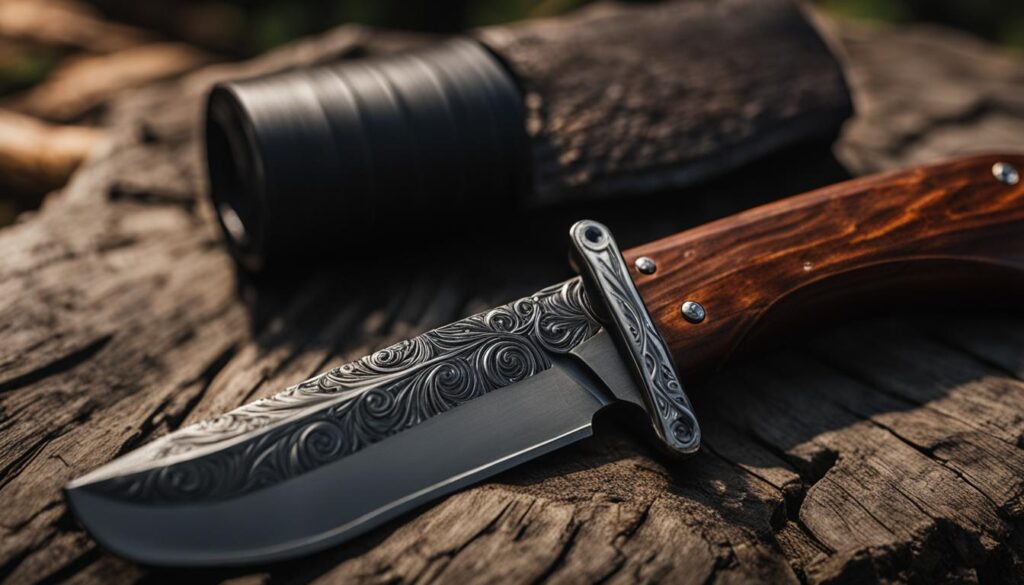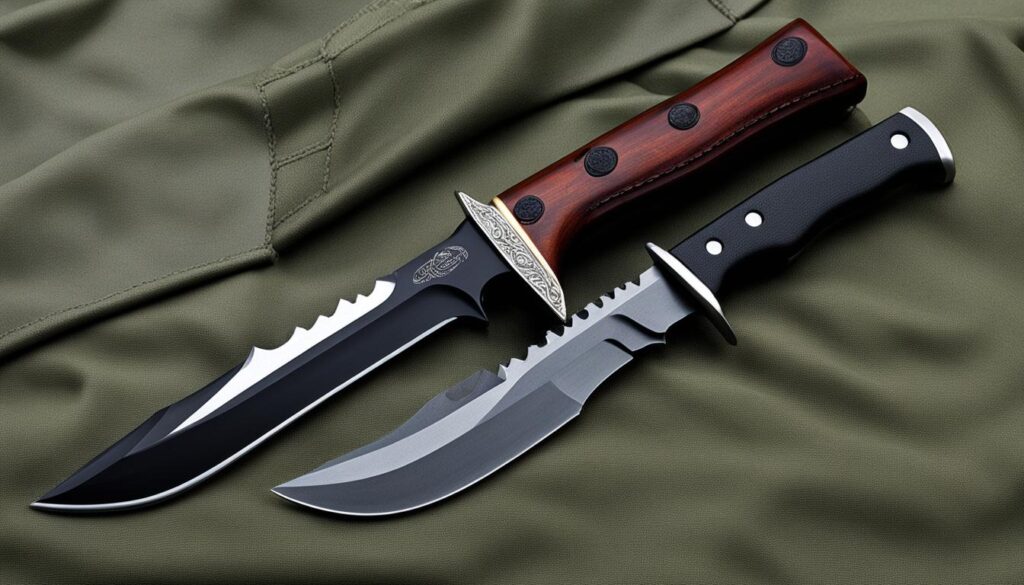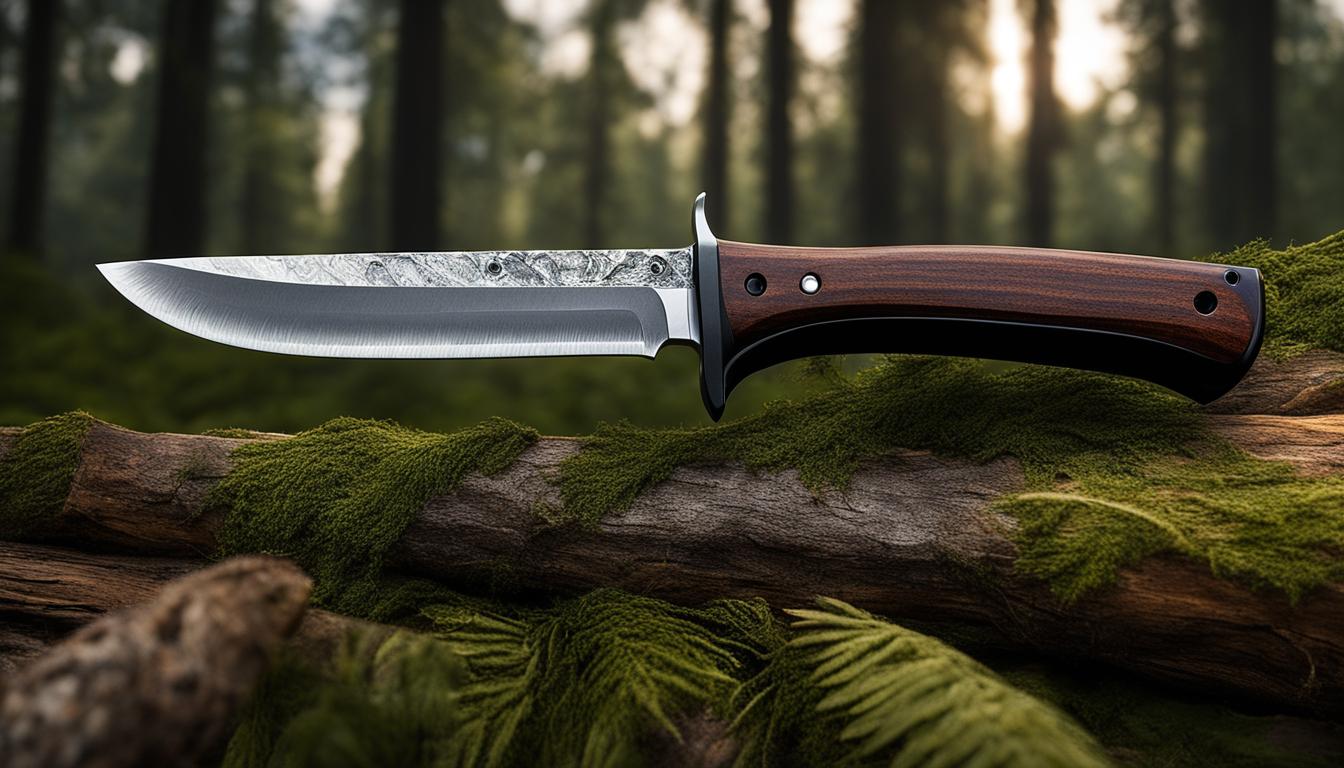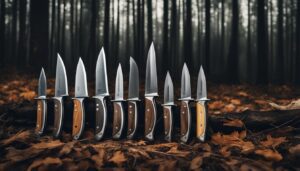Choosing the right knife length is crucial for achieving precision and versatility in hunting. A well-suited knife length ensures optimal performance and ease of use in various hunting tasks. Factors such as blade material, blade style, handle material, and sheath options also play a significant role in selecting the best hunting knife.
Key Takeaways:
- The ideal hunting knife length depends on specific tasks and personal preferences.
- A blade length between 3 to 5 inches is recommended for general-purpose hunting.
- Consider factors like blade material, blade style, handle material, and sheath options when choosing a hunting knife.
- High-quality hunting knives, such as the Benchmade Raghorn, Outdoor Edge WildPak, and MKC Stonewall Skinner, are highly recommended.
- Fixed blade knives offer strength and durability, while folding blade knives provide compactness and ease of transport.
Factors to Consider: Blade Material and Blade Style
When it comes to choosing a hunting knife, two important factors to consider are the blade material and blade style. The blade material can greatly impact the performance and durability of the knife, while the blade style determines its functionality for different hunting tasks.
Blade Material:
The choice of blade material for a hunting knife is crucial. It determines the knife’s ability to hold an edge, its resistance to corrosion, and its overall strength. Two of the most popular blade materials for hunting knives are stainless steel and high-carbon steel.
Stainless steel blades offer excellent corrosion resistance, making them ideal for use in wet and humid environments. They are also relatively easy to maintain and are less prone to staining or rusting. On the other hand, high-carbon steel blades have superior edge retention and durability. They can withstand heavy use and are more resistant to chipping or breaking.
Quote: “Stainless steel blades are great for hunters who need a knife that can handle various environmental conditions without worrying about rust. High-carbon steel blades, on the other hand, offer exceptional strength and edge retention, making them perfect for hunters who demand durability and long-lasting performance.” – Knife expert
Blade Style:
Another important aspect to consider is the blade style of the hunting knife. Different blade styles are designed for specific hunting tasks, such as skinning, gutting, or field dressing.
Some of the most common blade styles include:
- Drop Point Blade: This blade style features a curved edge and a sharp point, making it versatile for a wide range of tasks. It is ideal for general-purpose hunting and offers excellent control for precise cuts.
- Clip Point Blade: The clip point blade has a thinner, more defined point, which makes it suitable for detailed work such as caping or skinning. It provides better piercing capability but may be less durable.
- Gut Hook Blade: This unique blade style has a curved, sharpened hook on the spine, specifically designed for field dressing. It allows for quick and effortless gutting without puncturing internal organs.
| Blade Style | Uses | Pros | Cons |
|---|---|---|---|
| Drop Point Blade | General-purpose hunting | Versatile, precise cuts | May be less durable |
| Clip Point Blade | Detail work, skinning | Better piercing capability | Less durability |
| Gut Hook Blade | Field dressing | Effortless gutting | May be less versatile for other tasks |
Choosing the right blade material and style is essential to ensure that your hunting knife performs optimally and meets your specific needs in the field.
Factors to Consider: Handle Material and Blade Length
When choosing a hunting knife, two important factors to consider are the handle material and the blade length. These elements play a significant role in the knife’s performance, comfort, and durability during hunting activities. Let’s explore these factors in more detail.
Handle Material
The handle material of a hunting knife is crucial as it directly affects the grip, comfort, and overall usability of the knife. There are several options to choose from, including wood, rubber, and synthetic materials.
A wood handle provides a classic and natural feel, offering warmth and aesthetic appeal. It can provide an excellent grip, but it may require more maintenance to prevent moisture damage. Rubber handles, on the other hand, offer a secure and non-slip grip, even in wet conditions. This makes them ideal for hunting in rainy or humid environments. Synthetic handles, such as those made from composite materials, offer a balance of durability, grip, and resistance to extreme weather conditions.
Hunting Knife Blade Length
The blade length is another important consideration when selecting a hunting knife. The optimal blade length depends on the specific hunting tasks and personal preferences.
For general-purpose hunting, a blade length between 3 to 5 inches is recommended. This range strikes a balance between versatility and maneuverability. With a blade of this length, you can comfortably perform tasks such as field dressing, skinning, and preparing game meat.
Remember that different hunting activities may require different blade lengths. For example, a longer blade may be beneficial for tasks like chopping wood or clearing brush, while a shorter blade may offer more precision for fine tasks like caping.
Table: Comparing Handle Materials
| Handle Material | Pros | Cons |
|---|---|---|
| Wood | Natural feel Aesthetic appeal |
Requires maintenance Vulnerable to moisture |
| Rubber | Secure grip Non-slip even in wet conditions |
May wear out over time |
| Synthetic | Durable Weather-resistant |
May lack the “warmth” of natural materials |
Choosing the right handle material and blade length for your hunting knife is essential to ensure a comfortable and effective hunting experience. Consider the specific requirements of your hunting activities and select a knife that best suits your needs.

Factors to Consider: Sheath and Carry Options
When selecting a hunting knife, it’s important to consider the sheath and carry options available. The sheath not only provides safe storage for the knife but also ensures easy access when needed. Additionally, the quality and design of the sheath play a significant role in the overall functionality and convenience of carrying the knife.
A well-designed sheath should securely hold the knife in place, preventing accidental falls or slips. It should also allow for quick and effortless retrieval of the knife whenever required. The sheath should have a snug fit, holding the knife firmly in place, and preferably have a locking mechanism or retention system to provide added security.
Convenience is another crucial factor to consider when evaluating sheath options for a hunting knife. The sheath should be easy to attach to a belt or gear, ensuring that the knife is readily accessible during hunting expeditions. Some sheaths may also offer additional carrying options, such as MOLLE compatibility or attachment loops for carrying on backpacks or vests.
Table: Comparison of Hunting Knife Sheath Options
| Sheath Option | Features | Advantages | Disadvantages |
|---|---|---|---|
| Nylon Sheath | – Lightweight and durable | – Easy to clean and maintain | – May not offer optimal blade protection |
| Leather Sheath | – Classic and aesthetically pleasing | – Provides excellent blade protection | – Requires periodic maintenance |
| Kydex Sheath | – Rugged and weather-resistant | – Offers secure retention and quick deployment | – May be bulkier compared to other options |
| Hybrid Sheath | – Combines the advantages of different materials | – Provides a balance between functionality and aesthetics | – May be more expensive |
Ultimately, the choice of a hunting knife sheath should be based on personal preference and the specific requirements of the hunting activities. Consider factors such as durability, ease of use, and comfort while evaluating different sheath options. A high-quality sheath is an essential accessory that enhances the overall performance and usability of a hunting knife.
Recommended Hunting Knives
When it comes to hunting knives, having a reliable and high-quality tool is essential. There are several top-notch hunting knife brands that have consistently delivered outstanding performance. Let’s take a closer look at some of the best hunting knives available:
Benchmade Raghorn
The Benchmade Raghorn is a popular choice among hunters for its exceptional craftsmanship and durability. It features a fixed blade design with a 3.5-inch drop point blade, making it versatile for various hunting tasks. The stainless steel blade ensures excellent edge retention while providing corrosion resistance. With a comfortable handle and a reliable sheath, the Benchmade Raghorn is a trustworthy companion in the field.
Outdoor Edge WildPak
The Outdoor Edge WildPak is a comprehensive hunting knife set that offers everything you need for field dressing and processing game. It includes a variety of blades, such as a gut hook, caping knife, boning knife, and a dual-function saw. The blades are made from high-quality stainless steel, ensuring long-lasting sharpness. The rubberized handles provide a secure grip, even in wet conditions. With a convenient carrying case, the Outdoor Edge WildPak is perfect for hunters who want versatility and functionality in one package.
MKC Stonewall Skinner
The MKC Stonewall Skinner is a top-of-the-line hunting knife known for its exceptional cutting performance. It features a 4.3-inch CPM-S30V stainless steel blade, which offers excellent edge retention and corrosion resistance. The drop point blade design allows for precise skinning and dressing of game. The ergonomic handle provides a comfortable grip, allowing for extended use without fatigue. With its superior craftsmanship, the MKC Stonewall Skinner is a favorite among avid hunters.
| Knife Brand | Blade Material | Blade Length | Handle Material |
|---|---|---|---|
| Benchmade Raghorn | Stainless Steel | 3.5 inches | Wood |
| Outdoor Edge WildPak | Stainless Steel | Various blades | Rubber |
| MKC Stonewall Skinner | CPM-S30V Stainless Steel | 4.3 inches | Synthetic |
When choosing a hunting knife, it’s important to consider your specific needs and preferences. The Benchmade Raghorn, Outdoor Edge WildPak, and MKC Stonewall Skinner are all excellent options that have been highly regarded by hunters. Each knife offers its own unique features and benefits, allowing you to find the perfect tool for your hunting adventures.
Fixed Blade vs. Folding Blade: Which Is Right for You?
When it comes to selecting a hunting knife, one of the key decisions you’ll need to make is whether to go with a fixed blade or a folding blade design. Both options have their own advantages and considerations, so it’s important to weigh them carefully to determine which one is right for you.
The Pros and Cons of Fixed Blade Knives
Fixed blade hunting knives offer unmatched strength and durability. Their solid construction and lack of moving parts make them highly reliable and less prone to failure in intense hunting situations. Fixed blade knives also tend to have a larger, more robust blade, allowing for greater cutting power and versatility in the field. They offer quick and easy deployment, making them ideal for tasks that require speed and efficiency.
On the downside, fixed blade knives are bulkier and less compact compared to folding blade knives. This can make them slightly more challenging to carry and store. Additionally, the exposed blade of a fixed blade knife requires extra caution during transport and handling to ensure safety.
The Pros and Cons of Folding Blade Knives
Folding blade hunting knives are prized for their compactness and portability. They feature a blade that can be folded into the handle, making them incredibly convenient for carrying in a pocket or backpack. Folding blade knives often have additional safety features such as locking mechanisms to prevent accidental blade closure during use. They are also generally more discreet, making them a popular choice for everyday carry.
However, the folding mechanism of these knives introduces a potential point of failure. Moving parts can wear out over time or become damaged, affecting the overall performance and reliability of the knife. The smaller blade size of folding knives may also limit their cutting power and versatility compared to fixed blade knives.
Ultimately, the choice between a fixed blade and folding blade hunting knife depends on your personal preferences, intended use, and specific hunting needs. Consider factors such as portability, reliability, cutting power, and safety features to make an informed decision that aligns with your hunting style.
| Pros of Fixed Blade Knives | Cons of Fixed Blade Knives |
|---|---|
| 1. Unmatched strength and durability | 1. Bulkier and less compact |
| 2. Larger, more robust blade | 2. Exposed blade requires extra caution |
| 3. Quick and easy deployment |
| Pros of Folding Blade Knives | Cons of Folding Blade Knives |
|---|---|
| 1. Compact and portable | 1. Potential point of failure with moving parts |
| 2. Additional safety features | 2. Smaller blade size limits cutting power |
| 3. Discreet and versatile for everyday carry |
Ideal Knife Length for Hunting and Survival
Choosing the ideal knife length for hunting requires careful consideration of the specific tasks and requirements. When it comes to hunting, a blade length between 3 to 4 inches is generally recommended for optimal performance and versatility. A knife of this size strikes a balance between nimbleness for field dressing and the ability to handle other outdoor tasks effectively. The suitable blade length for hunting may vary based on personal preferences and hunting conditions, but a 3 to 4-inch blade provides the versatility needed for various hunting situations.
Additionally, a hunting knife can also serve as a valuable tool for survival situations. In survival scenarios, having a reliable knife can make a significant difference. A fixed blade knife with a full tang and extended tang offers the necessary strength and functionality for a wide range of survival tasks, such as building shelters, crafting tools, and processing food. The durability and versatility of an appropriately sized hunting knife make it a valuable asset for not only hunting but also surviving in challenging outdoor environments.
When considering the best knife length for survival, it’s essential to balance portability and functionality. A knife that is too short may limit its utility for survival tasks, while a knife that is too long may become cumbersome to carry and handle. Therefore, a blade length between 3 to 4 inches for survival purposes provides a good compromise between maneuverability and effectiveness in various survival situations.
| Advantages of an Ideal Hunting Knife Length | Disadvantages of an Ideal Hunting Knife Length |
|---|---|
|
|
Ultimately, the ideal knife length for hunting and survival depends on the individual’s preferences, hunting requirements, and outdoor situations. It is crucial to select a knife that feels comfortable in hand, offers the necessary functionality, and suits the intended purposes. By considering the factors mentioned above, hunters and outdoor enthusiasts can make an informed decision when choosing the best knife length for their needs.


Conclusion
After considering various factors, it is clear that selecting the right hunting knife length is crucial for precision and versatility in the field. By taking into account blade material, blade style, handle material, and sheath options, you can make an informed decision and choose a knife that meets your specific needs.
Choosing the right hunting knife is not a decision to be taken lightly. It is important to invest in a high-quality knife that will enhance your hunting experience and ensure your safety. A well-designed and durable hunting knife can make all the difference when it comes to field dressing game and performing other outdoor tasks.
In conclusion, remember that the ideal hunting knife length falls between 3 to 5 inches for general-purpose hunting. However, the specific tasks you plan to undertake and your personal preferences should also be taken into consideration. It is worth spending time researching and evaluating different options to find the perfect hunting knife for you.
FAQ
What factors should I consider when choosing a hunting knife?
When choosing a hunting knife, you should consider factors such as blade material, blade style, handle material, sheath options, and blade length. These factors impact the knife’s performance, durability, and functionality.
What are the different blade styles available for hunting knives?
Hunting knives come in various blade styles, including drop point, clip point, and gut hook. Each style is suited for specific hunting tasks, such as field dressing or skinning game.
What handle materials are commonly used in hunting knives?
Common handle materials for hunting knives include wood, rubber, and synthetic options. The handle material should provide a comfortable and secure grip, even in wet or cold conditions.
What is the recommended blade length for general-purpose hunting?
For general-purpose hunting, a blade length between 3 to 5 inches is recommended. This length offers the right balance between nimbleness for field dressing and versatility for other outdoor tasks.
How important is the sheath that comes with a hunting knife?
The sheath that comes with a hunting knife is important for safe storage and easy access. The quality and design of the sheath should be considered, including its ability to securely carry the knife on a belt or in a pack.
Can you recommend any specific hunting knives?
Highly recommended hunting knives include the Benchmade Raghorn, Outdoor Edge WildPak, and MKC Stonewall Skinner. These knives are known for their durability and functionality in the field.
What are the advantages of fixed blade and folding blade hunting knives?
Fixed blade knives offer strength and durability, while folding blade knives are more compact and easier to transport. The choice between the two depends on your specific needs and preferences.
What is the ideal knife length for hunting and survival?
The ideal knife length for hunting generally falls between 3 to 4 inches. This length provides the necessary precision for field dressing while maintaining versatility for other outdoor tasks. For survival situations, a fixed blade knife with a full tang and extended tang offers the strength and functionality needed for various tasks.
What should I consider when choosing a hunting knife?
When choosing a hunting knife, consider factors such as blade material, blade style, handle material, sheath options, and blade length. These factors are crucial for precision, versatility, and safety in the field.





